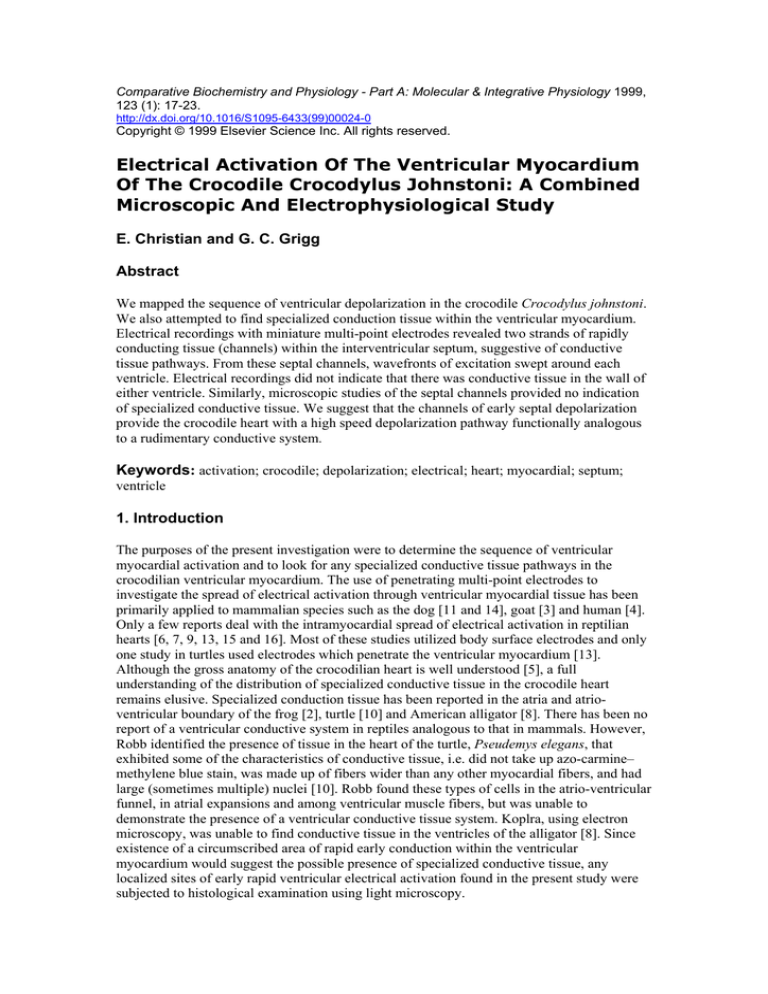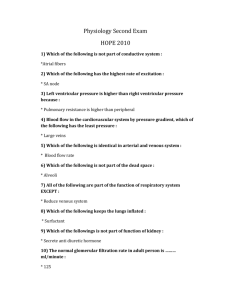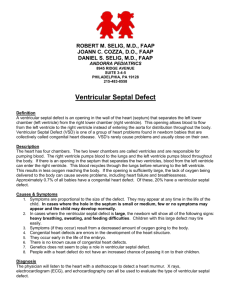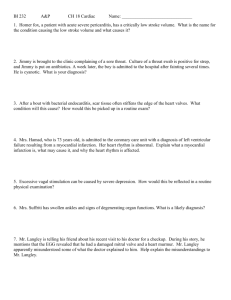
Comparative Biochemistry and Physiology - Part A: Molecular & Integrative Physiology 1999,
123 (1): 17-23.
http://dx.doi.org/10.1016/S1095-6433(99)00024-0
Copyright © 1999 Elsevier Science Inc. All rights reserved.
Electrical Activation Of The Ventricular Myocardium
Of The Crocodile Crocodylus Johnstoni: A Combined
Microscopic And Electrophysiological Study
E. Christian and G. C. Grigg
Abstract
We mapped the sequence of ventricular depolarization in the crocodile Crocodylus johnstoni.
We also attempted to find specialized conduction tissue within the ventricular myocardium.
Electrical recordings with miniature multi-point electrodes revealed two strands of rapidly
conducting tissue (channels) within the interventricular septum, suggestive of conductive
tissue pathways. From these septal channels, wavefronts of excitation swept around each
ventricle. Electrical recordings did not indicate that there was conductive tissue in the wall of
either ventricle. Similarly, microscopic studies of the septal channels provided no indication
of specialized conductive tissue. We suggest that the channels of early septal depolarization
provide the crocodile heart with a high speed depolarization pathway functionally analogous
to a rudimentary conductive system.
Keywords: activation; crocodile; depolarization; electrical; heart; myocardial; septum;
ventricle
1. Introduction
The purposes of the present investigation were to determine the sequence of ventricular
myocardial activation and to look for any specialized conductive tissue pathways in the
crocodilian ventricular myocardium. The use of penetrating multi-point electrodes to
investigate the spread of electrical activation through ventricular myocardial tissue has been
primarily applied to mammalian species such as the dog [11 and 14], goat [3] and human [4].
Only a few reports deal with the intramyocardial spread of electrical activation in reptilian
hearts [6, 7, 9, 13, 15 and 16]. Most of these studies utilized body surface electrodes and only
one study in turtles used electrodes which penetrate the ventricular myocardium [13].
Although the gross anatomy of the crocodilian heart is well understood [5], a full
understanding of the distribution of specialized conductive tissue in the crocodile heart
remains elusive. Specialized conduction tissue has been reported in the atria and atrioventricular boundary of the frog [2], turtle [10] and American alligator [8]. There has been no
report of a ventricular conductive system in reptiles analogous to that in mammals. However,
Robb identified the presence of tissue in the heart of the turtle, Pseudemys elegans, that
exhibited some of the characteristics of conductive tissue, i.e. did not take up azo-carmine–
methylene blue stain, was made up of fibers wider than any other myocardial fibers, and had
large (sometimes multiple) nuclei [10]. Robb found these types of cells in the atrio-ventricular
funnel, in atrial expansions and among ventricular muscle fibers, but was unable to
demonstrate the presence of a ventricular conductive tissue system. Koplra, using electron
microscopy, was unable to find conductive tissue in the ventricles of the alligator [8]. Since
existence of a circumscribed area of rapid early conduction within the ventricular
myocardium would suggest the possible presence of specialized conductive tissue, any
localized sites of early rapid ventricular electrical activation found in the present study were
subjected to histological examination using light microscopy.
2. Materials and methods
Penetrating multi-point electrodes were used to record the spread of electrical activity through
the ventricular myocardium of the crocodile C. johnstoni. The sequence of ventricular
excitation was mapped by recording the progression of activity through the myocardium at
394 electrode points in five hearts. An average of ten electrodes, with eight electrode points
per electrode, were placed in each heart. All recordings were taken during normal sinus
rhythm.
2.1. Construction of multi-point electrodes
The side of a 29-gauge hypodermic needle was shaved so that the terminal 15 mm of the shaft
were patent laterally. Eight cadmium–nickel insulated wires with a diameter of 22.60 m, 80
cm long and with an electrical resistance of 154 /m were passed through the lumen of the
needle. The tips of eight wires exited the needle lumen laterally in the shaved area at 1- m
intervals and formed the electrode points. The lumen of the needle was filled with an epoxy
resin, which cured and secured the electrode points in place. Fig. 1 shows a lateral view of the
electrode with individual electrode points exiting at 1-mm intervals.
Fig. 1. A portion of a multi-point needle electrode showing individual electrode points positioned at 1mm intervals along the needle shaft.
2.2. Surgical protocol
Five Australian fresh-water crocodiles, C. johnstoni, weighing 1.90–2.52 kg, were used. Lead
II electrocardiogram electrodes were placed for monitoring QRS waveform shape and
duration. Each crocodile was anesthetized via intracardiac injection of phenobarbital (30
mg/kg body weight). The QRS complex showed no change in shape or duration following
anesthesia. The thoracic cavity was opened with a midline incision and the heart was exposed.
Respiratory ventilation was accomplished with an external air pump via tracheal intubation.
2.3. Experimental protocol
Once temperature and heart rate were stable, multi-point electrodes were inserted into the
myocardium. The depth of insertion and position of each electrode was noted. Each electrode
was checked periodically in order to maintain control of electrode point location within the
myocardium. The exact number of electrodes depended upon such factors as thickness of the
ventricular wall and the amount of muscle injury (S–T segment shift). The position of each
electrode, angle of penetration and depth of insertion were recorded. At least two electrodes
were placed in similar locations in the septum and midleft ventricle in each heart, in order to
check similarity of excitation pathway between hearts. Following the disappearance of injury
potentials, electrical activity was recorded at each electrode position. Fig. 2 shows a typical
bipolar recording. Once all data were collected from each heart, the electrode track was
marked with india ink. The heart was excised and fixed in a 10% formalin solution. Serial
2.5-mm sections of the preserved heart were made so that the dye-marked track of each
electrode and the position of each electrode point could be located. These serial sections were
used to make a map of the recording points and the electrical activation times at each point.
Fig. 2. A typical bipolar recording of a depolarization wavefront within the crocodile myocardium.
Recordings were made using a multi-point needle electrode. The electrode was placed in the dorsal
aspect of the left ventrical, indicated on the inset drawing of the heart by a dotted line. Recording point
number 1 is indicated by a circle and was 5 mm from the dorsal boundary of the left and right
ventricles. Recording point number 8 is indicated by a square and was 8 mm from the dorsal boundary
of the left and right ventricles. The trace with the large vertical excursion is a lead II ECG.
2.4. Collection of experimental data
Bipolar recordings were collected from sets of two electrode points per recording channel (i.e.
point number 1 versus point number 2, point number 2 versus point number 3, etc.). A
multiplexer distributed data to a Techtronics 5103N dual-beam oscilloscope. Oscilloscope
beam number 1 was multiplexed into eight channels for bipolar recordings. The second beam
displayed the lead II body surface electrocardiogram (ECG), which was used as a time base.
Hard copy records were obtained by photographing the oscilloscope screen.
2.5. Histological methods
Each of the five hearts was excised and fixed in 10% formalin. Using standard histological
technique, 1- m cross-sections were taken at 2.5-mm intervals starting at the heart base. Each
section was stained with toluidine blue and examined with light microscopy.
3. Results
3.1. Anatomy
In the crocodile heart, muscle fibers of the septum appear to continue into the left ventricular
wall and run parallel to the fibers of the left ventricle giving the septum and left ventricle the
appearance of one continuous conical unit. The right ventricle appears to be a half cone
attached to the conically shaped left ventricle. Dependent on the size of an individual heart,
the apex of this right ventricular half cone ends approximately 5 mm basal to the apex of the
left ventricular cone. The fibers of the right ventricle course from their attachment to the left
ventricular cone at an angle from both the septal fibers and ventricular fibers and do not run
parallel to either. The crocodiles used in this study had an average heart size of 22.6 mm long
(range 20–26 mm), 24.4 mm wide at the base (range 15–30.5 mm) and had a dorsoventral
thickness at the base of 17.5 mm (range 13–21 mm).
3.2. Setting the time base
The beginning of the QRS complex was designated as time zero (T=0). The electrical
activation times recorded at each electrode position were grouped into seven 15-ms time
periods from 15 ms before T=0 to 90 ms following T=0. The activation time for each
electrode recording point was logged. This gave time versus position data which were then
plotted in the appropriate cross-sectional serial section of the ventricles. Conduction speed
was calculated using distance between electrodes divided by the time delay of recorded
electrical activity. The cross-sectional plot of activation times is shown in Fig. 3.
Fig. 3. Representation of the three-dimensional spread of depolarization through the ventricles of the
crocodile C. johnstoni. Depolarizing areas are indicated in black; depolarized areas are hatched. Areas
not depolarized or where no recordings were obtained are blank; in the time frame 76–90 ms, the blank
areas indicate that there were no recordings.
3.3. Sequence of electrical activation
The interventricular septum exhibits the earliest electrical activation times, showing activity
as early as 5 ms prior to the beginning of the QRS complex (T=0). This early activity
occurred in two narrow channels of 2–3 mm diameter each. One channel was located in midseptum, approximately 8–10 mm from the dorsal septal border. The second channel was
located approximately 1–3 mm from the dorsal border of the septum. These channels of rapid
conduction appear to stop approximately 5 mm from the apex of the left ventricle. Cell to cell
conduction speed in these channels was estimated to be 1.25 m/s. Septal recordings prior to
T=0 were obtained from all animals with each heart showing two distinct areas of rapid
conduction. Electrical excitation spread from the early activation channels throughout the rest
of the septum at a speed of approximately 0.65 m/s.
Activation of the fibers of the left ventricle begins at both the dorsal and ventral borders of the
interventricular septum in a line along the septal–ventricular boundary. Activation of the
dorsal portion of the ventricular wall precedes that of the ventral wall by 3–4 ms. Once these
septal boundary areas have been activated, the waves of electrical activation sweep from both
boundaries outward around the left ventricular cone in separate dorsal and ventral wavefronts
at a speed of approximately 0.65 m/s. The two wavefronts converged approximately 3 mm
ventral to the lateral midline of the left ventricle. The entire middle section of the left
ventricular cone was activated by T=45 ms. The apex of the left ventricle depolarized slightly
later, being completely activated by T=60 ms.
Once the dorsal and ventral septal right ventricular boundaries were activated, the wavefront
appeared to sweep from both boundaries around the hemicone of the right ventricle at a speed
of 0.45 m/s. Complete activation of the right ventricle lagged activation of the left ventricle
by 15 ms. The last part of the crocodile heart to be activated in each cycle was the base of
both the left and right ventricles. Small sections located in both left and right lateral portions
of these basal segments were not activated until T=75 ms. Although the ECG did not return to
baseline until T=90 ms, no points of activity were recorded between T=75 and T=90 ms.
Unlike studies of the spread of depolarization through the myocardium in other species,
differential endocardial to epicardial spread within the ventricles of the crocodile was not
observed.
3.4. Histological findings
None of the cells in the areas of rapid early conduction of electrical activity showed staining
characteristics of specialized conductive cells. Likewise, no conductive tissue was identified
anywhere within the ventricles of C. johnstoni.
4. Discussion
4.1. Mechanism of electrical activation
Activation appears to start in the interventricular septum just below the base of the heart. The
initial wavefront spreads down two narrow pathways to points near the apical termination of
the interventricular septum. From these septal areas of early excitation, activity spreads
towards both the dorsal and ventral septum–ventricular wall boundaries. From both the dorsal
and ventral septum–ventricular wall boundaries, a wavefront of electrical activity spreads into
the left ventricle (see Fig. 4). These two wavefronts course around the left ventricular cone
and meet in the lateral portion of the ventricular wall approximately 3 mm ventral to the
lateral midline. The right ventricle appears to activate from the septal–right ventricular wall
boundaries. Wavefronts similar to those in the left ventricle converge near the right lateral
region of the right ventricle. The left ventricular apex below the termination of the septum
appears to be depolarized later than the rest of the left ventricular cone. The last portion of the
ventricles to depolarize is two small areas on the left and right lateral base. The late
depolarization of the right ventricular base corresponds partially with observations made by
White [17]. The activation time for the right ventricular base seen in the current data from C.
johnstonii was much shorter (T<90 ms) than the time reported by White (T=350 ms).
However, the activation time recorded in our study for the right ventricular base was late in
the QRS complex. This would produce late contractile activity in the subpulmonary conus. If
late contraction of the musculature of the crocodilian conus is important in the development
of a pulmonary-to-systemic arterial shunt, our data do not counter that conclusion.
Fig. 4. An artist’s representation of the movement of electrical activation in the ventricular
myocardium of the crocodile C. johnstoni. Note that this representation is not to scale.
4.2. Wavefront movement through the layers of the myocardium
In the depolarization of the mammalian myocardium the endocardium generally precedes the
epicardium. The mammal heart possesses a network of conductive cells that excite a large
portion of the endocardium prior to the epicardium. In the crocodile no evidence of
conductive cells was obtained. Additionally, no differential excitation between the layers of
the myocardium was observed. Although the data from the crocodile ventricular wall suggest
that activation is a uniform wall thickness wavefront, the issue is clouded by data collection
difficulties. The crocodile left ventricular wall is approximately 2 mm thick. Since the
recording electrode points were 1 mm apart, a maximum of two recording points were
possible from an electrode inserted perpendicular to the heart wall. Data from these
perpendicular electrodes showed identical activation times for the electrode points within the
heart wall. This supports a supposition of uniform wall thickness conduction. However,
because of the relatively small number of recording points obtained, care must be used in
making a general statement about a uniform endocardial–epicardial wavefront. Conduction
speeds in the crocodile myocardium are approximately half the conduction velocities reported
in mammals [3, 4, 11 and 14]. Only the two bands of rapid septal activation approached
mammalian conduction speeds. The conduction speeds in our data are, however, significantly
faster than the speeds for the turtle reported by Burggren: 0.07–0.08 m/s during periods of
lung ventilation and 0.15 m/s during periods of apnea [1].
4.3. Possible presence of conductive tissue
Electrical activity within the septum is very similar to septal activity in mammals—i.e. the
existence of pathways of early rapid electrical conduction. The existence of these pathways
and the fact that activity in these areas preceded the beginning of the QRS complex may
indicate the presence of specialized conductive cells. Additionally, the late depolarization of
the basal regions of the ventricles suggests a dependence on a conduction system. However,
our histological data do not show the presence of any conductive tissue. Our inability to
identify specific conductive cells histologically may not be proof positive of their absence.
Koplra noted in comparative histological studies of cardiac conductive systems that "the
morphological basis for the identification of the system has, however, been criticized since
cells with primarily conducting properties cannot in all species be clearly distinguished from
cells with primarily contractile properties" [8]. Thus, we can say that there is strong
electrophysiological support for conductive activity in the crocodile septum, but the
histological evidence does not indicate the existence of any specialized conductive cells.
From the electrical recordings in the ventricular walls and histological data no evidence was
seen of a conduction system similar to the Purkinje system of mammals.
4.4. Possible significance of fast septal pathways in the crocodile
It appears that two bands of ventricular septal cells allow the rapid spread of activation toward
the apex of the heart. Some electrical isolation of these bands at the base of the septum seems
likely, because the apical areas of the ventricles are depolarized before both of the ventricular
bases. Therefore these bands of early septal activity serve the function of a rudimentary
conduction pathway through the septum. The question that arises here is that if no conductive
cells were seen histologically, how can these fast septal pathways be explained? The answer
may be muscle fiber orientation. Scher et al. reported that in the dog conduction down the
longitudinal axis (anisotropic) of myocardial cells is 2.5 times faster than conduction
perpendicular to the muscle fibers [12]. Our data show a ratio of 1.92 to 1 between speed of
conduction in the septal bands and the adjacent septal areas. It is possible that these fast band
cells in the crocodile septum are arranged so that conduction is anisotropic. This cannot,
however, be verified from our data, since no determination of fiber orientational relationships
to recording electrodes was made. This is an area that should be explored in future
investigation. Additionally, Burggren reported a reversal of the pattern of depolarization in
the heart of the turtle Testudo graeca, when going from a state of full respiratory ventilation
to apnea [1]. He ascribed this to a cardiac contribution to the pulmonary blood shunt. If the
blood shunt in crocodiles has a comparable cardiac mechanism the two bands of early septal
excitation might play a role in alteration of the excitation pathway during apnea. All our data
were gathered during full ventilation. It might be of interest to repeat our experiment under
conditions that change from lung ventilation to apnea.
In conclusion, our data show for the first time the sequence of electrical activation through the
ventricular myocardium of the crocodile. The data indicate that the left and right ventricles of
the crocodile heart are activated in similar patterns proceeding from the dorsal and ventral
septal–ventricular wall boundaries laterally and in an axis that is generally from apex to base.
Activation of the left ventricle precedes the right by several milliseconds. Although no
specialized conductive tissue was found histologically, our electrical recordings did uncover
two bands of fast conducting septal cells, which does support the conclusion that some form
of specialized conductive activity in the crocodile ventricular septum exists. No Purkinje-like
cells were found within the ventricular wall of either ventricle.
References
1. W.W. Burggren, Form and function in reptilian circulations. Am Zool 27 (1987), pp. 5–19.
2. P.F. Cranefield, The atrioventricular node and the ventricular conducting system in the nonmammalian vertebrate heart. Ann New York Acad Sci 127 (1965), pp. 145–150.
3. D. Durrer and L.H. van der Tweel, Excitation of the left ventricular wall of the dog and goat. Ann
New York Acad Sci 65 (1957), pp. 779–803.
4. D. Durrer, R.T. van Dam, G.E. Freud, M.J. Janse, F.L. Meijler and R.C. Arzbaecher, Total excitation
of the isolated human heart. Circulation 16 (1970), pp. 899–908.
5. G.C. Grigg, Central cardiovascular anatomy and function in crocodilia. In: S. Wood and R. Weber,
Editors, Strategies of physiological adaptation. Proceedings of the Kjell Memorial, Munksgard,
Copenhagen (1991).
6. A.S. Harris, The spread of excitation in the turtle, dog, cat, and monkey ventricles. Am J Physiol 134
(1941), pp. 319–322.
7. H.M. Kaplan and C. Schwartz, Electrocardiography in turtles. Life Sci 9 (1963), pp. 637–645.
Abstract
8. E.C. Koplra, The ultrastructure of alligator conductive tissue: an electron microscopic study of the
sino-atrial node. Acta Physiol Hung 69 1 (1987), pp. 27–84.
9. R.K. Mullen, Comparative electrocardiology of the squamata. Physiol Zool 40 (1967), pp. 114–216.
10. J.S. Robb, Specialized (conducting) tissue in the turtle heart. Am J Physiol 172 (1953), pp. 7–13.
11. A.M. Scher and A.C. Young, Ventricular depolarization and the genesis of QRS. Ann New York
Acad Sci 65 (1957), pp. 768–778.
12. A.M. Scher, D.E. Roberts and L.T. Herch, Influence of cardiac fiber orientation on wavefront
voltage, conduction velocity, and tissue resistivity in the dog. Circ Res 44 (1979), pp. 701–712.
13. K.N. Shmakov and M.P. Roshchevskii, Intramural chronotopography of cardiac ventricular
depolarization in reptiles. Zh Evol Biokhim Fizol 18 3 (1982), pp. 164–169.
14. M.S. Spach and R.C. Barr, Ventricular intramural and epicardial potential distributions during
ventricular activation and repolarization in the intact dog. Circ Res 37 (1975), pp. 243–249.
15. M.E. Valentinuzzi, H.E. Hoff and L.A. Geddes, Observations on the electrical activity of the snake
heart. J Electrocardiol 2 (1969), pp. 39–50.
16. M.E. Valentinuzzi, H.E. Hoff ad and L.A. Geddes, Electrocardiogram of the snake: effect of the
location of the electrodes and cardiac vectors. J Electrocardiol 2 (1969), pp. 245–252.
17. F.N. White, Functional anatomy of the heart of reptiles. Am Zool 8 (1968), pp. 211–219.





